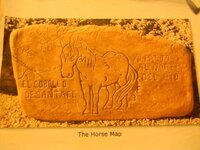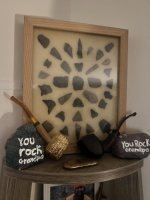Wayne, The flecks in the sandstone are probably natural, as sandstone has quite a lot of quartz or feldspar in it,
BB, the idea that steel is not as good these days as it was years ago is an urban myth, if you went to a forge master in a steel works and said that to him he would laugh at you,
there's no comparison between the best steels made today and those of a few hundred years ago, unless your using the cheap Chinese margarine metal tools that are sold at the large supermarkets and DIY places,
and drilling holes even in the softest sandstone until they invented electric drills they had to use a star drill and turn it by hand after each blow, and they were still part of a normal joiner and carpenters tool kit when i served my apprenticeship for plugging walls to put a door casing in or window frame skirting board etc, exactly the same way hard rock mining was done years ago, the only difference is the size of the drill used,
even the small holes rely on shock to break the grains apart, that's why an hammer drill is far better than a drill that goes round with no hammer action, and that's why if you've ever drilled holes in brick stone etc they now use tungsten/carbide, and even they wear quickly unless you use a green stone wheel to sharpen them,
the smaller the hole the more difficult to drill, and the less likely it will be round, because it needs tapping with a hammer and turning after each tap,
smoothing the grooves by rubbing yes, but even then they use a sharp edge or squared off end on whatever they rub it with,
even the best tool steel wears away very quickly if you try drilling stone with it, the speed also needs to be correct otherwise your not going to get anywhere fast,
a few months ago i saw a program where a stone mason in France turned a 2ft cube of sandstone into a full lions head complete with mane and muscle figuring an open mouth with teeth done as part of the renovation on Ruon Cathedral, open nostrils everything life like, and he carved it in two days all by hand,
a good stone masons apprentice with a few chisels and a carvers mallet could probably do the carving on the stones in his lunch hours over a couple of week, there is simply not enough work on them its first year apprentice stuff,
John
BB, the idea that steel is not as good these days as it was years ago is an urban myth, if you went to a forge master in a steel works and said that to him he would laugh at you,
there's no comparison between the best steels made today and those of a few hundred years ago, unless your using the cheap Chinese margarine metal tools that are sold at the large supermarkets and DIY places,
and drilling holes even in the softest sandstone until they invented electric drills they had to use a star drill and turn it by hand after each blow, and they were still part of a normal joiner and carpenters tool kit when i served my apprenticeship for plugging walls to put a door casing in or window frame skirting board etc, exactly the same way hard rock mining was done years ago, the only difference is the size of the drill used,
even the small holes rely on shock to break the grains apart, that's why an hammer drill is far better than a drill that goes round with no hammer action, and that's why if you've ever drilled holes in brick stone etc they now use tungsten/carbide, and even they wear quickly unless you use a green stone wheel to sharpen them,
the smaller the hole the more difficult to drill, and the less likely it will be round, because it needs tapping with a hammer and turning after each tap,
smoothing the grooves by rubbing yes, but even then they use a sharp edge or squared off end on whatever they rub it with,
even the best tool steel wears away very quickly if you try drilling stone with it, the speed also needs to be correct otherwise your not going to get anywhere fast,
a few months ago i saw a program where a stone mason in France turned a 2ft cube of sandstone into a full lions head complete with mane and muscle figuring an open mouth with teeth done as part of the renovation on Ruon Cathedral, open nostrils everything life like, and he carved it in two days all by hand,
a good stone masons apprentice with a few chisels and a carvers mallet could probably do the carving on the stones in his lunch hours over a couple of week, there is simply not enough work on them its first year apprentice stuff,
John



 <kidding>
<kidding>


